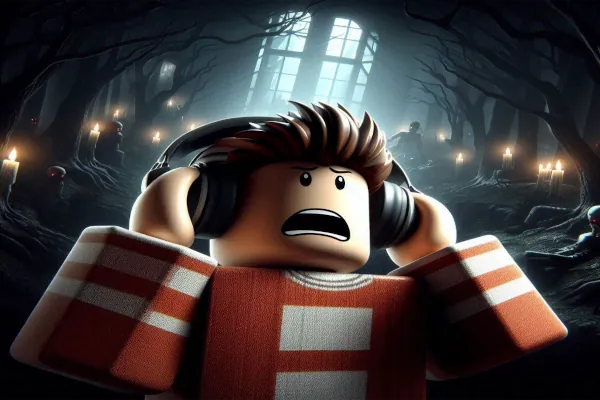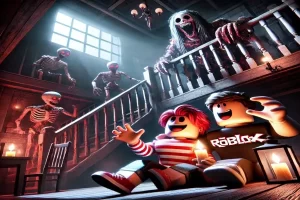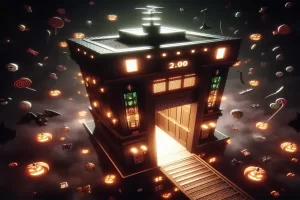Sound plays a crucial role in video games, especially in the horror genre, where it becomes an essential tool for crafting tension, fear, and immersion. In horror games, the right sound can make or break the atmosphere, heightening the player’s experience and often amplifying their sense of vulnerability. Whether it’s the eerie creak of a door, the distant howl of an unseen creature, or the sudden silence that precedes a jump scare, sound works in concert with visual and narrative elements to invoke fear.
On Roblox, horror games have mastered the art of using sound to intensify their terror. These games utilize a variety of sound effects—from unsettling ambient noises to bone-chilling monster growls—to keep players on edge. But it’s not just about adding spooky noises. Roblox horror games leverage sound to manipulate pacing, build suspense, and make the player feel like they’re in constant danger, even when nothing is happening on screen.
In this post, we’ll explore how sound design in Roblox horror games goes far beyond simple effects. It plays a pivotal role in creating a truly terrifying and immersive atmosphere, where every footstep and every whisper can signal something far worse lurking just out of sight.
The Role of Sound in Horror Games
Sound as an Emotional Trigger
In horror games, sound isn’t just a passive element—it’s an active force that shapes the player’s emotional experience. Well-designed sound effects can trigger powerful emotional reactions such as anxiety, fear, and tension, making the game’s events feel far more intense. Whether it’s a subtle hum in the background or the distant clatter of unseen footsteps, sound can immediately put players on edge, heightening their sensitivity to every visual and narrative cue.
The psychological impact of sound is profound. A sudden shift in music or the introduction of a high-pitched scream can trigger a fight-or-flight response, increasing the player’s heart rate and making them feel as if danger is imminent. These sound cues often work subconsciously, leaving players with a heightened sense of vulnerability, as their brain is constantly processing potential threats, even when nothing is physically threatening them. In horror, sound is crucial for creating that deep emotional connection with the environment, pulling players into a terrifying state of immersion where every creak or whisper feels like it might signal something dangerous nearby.
Types of Sounds Used in Horror Games
To effectively build tension, Roblox horror games use a wide range of sound categories, each serving a different purpose in shaping the overall fear experience:
- Ambient Noise: Background sounds such as wind howling, distant thunder, or the eerie hum of an old machine create an atmosphere of unease. These sounds are constant and subtle, slowly building tension and making players feel like something isn’t quite right.
- Jump Scares: These are the iconic horror game sounds that catch players off guard, like sudden loud noises, music spikes, or disturbing sound effects timed to an unexpected event. They exploit the element of surprise, triggering shock and fear at the most inopportune moments.
- Monster Noises: The growls, shrieks, and growls of creatures lurking nearby amplify the threat in horror games. These sounds signal danger, heighten anticipation, and make players hyper-aware of their surroundings, knowing that something monstrous could strike at any moment.
- Footsteps and Movement Sounds: Every step, creak of a floorboard, or rustle in the distance adds layers to the suspense. These sounds often signal the presence of something—or someone—approaching, and can evoke feelings of dread as players anticipate what might be following them.
Together, these sound categories form the backbone of horror in Roblox games, transforming an otherwise simple experience into something chilling and immersive. Sound is often the unseen antagonist, heightening every moment of fear and suspense in ways that visuals alone cannot achieve.
The Impact of Sound Cues on Gameplay
Warning and Alert Sounds
Sound cues in Roblox horror games are instrumental in creating a heightened sense of tension and urgency. These cues alert players to imminent danger, like the ominous growl of a monster in the distance, the faint scurrying of footsteps behind them, or the sudden increase in ambient noise as something approaches. These warning sounds act as signals, preparing players for what’s to come and putting them on high alert. The psychological effect of hearing these cues is profound, as players instinctively know that they’re being watched or hunted, which amplifies the fear factor.
The anticipation that builds from hearing these cues is part of what keeps players on edge. Every sound—whether it’s the faint rustling of leaves, a heavy breath, or the eerie creak of a door—keeps the player’s mind racing, wondering what could be lurking just out of sight. The tension in these moments is heightened by the unpredictability of when and where the danger will strike. Often, players won’t immediately know if the sound they just heard was a threat or just part of the environment, adding to the suspense and fear. This uncertainty forces them to stay alert and makes every moment in the game feel unpredictable.
Audio Feedback During Action
In addition to alerting players to threats, sound feedback also plays an essential role in gameplay, especially during actions like opening doors, interacting with objects, or solving puzzles. The sound of a door creaking open or the rustle of a drawer being pulled adds realism and weight to these actions, making them feel more immersive. In horror games, these small details are amplified, as the act of opening a door can create tension, especially if the surrounding sounds indicate something sinister may be waiting on the other side.
Audio feedback is also crucial when solving puzzles or progressing through the game. For example, players might hear a distinct sound when they solve a puzzle correctly, signaling that they are on the right track. Conversely, failing a task or being caught by an enemy can trigger a sharp, jarring sound that heightens the sense of failure or danger. These sounds not only provide feedback for the player’s actions but also enhance the atmosphere of dread by adding a layer of discomfort to every interaction.
For instance, in games like The Mimic, when players interact with mysterious objects or solve puzzles in dark, unsettling environments, the sounds of these actions contribute to the overall fear by making even the simplest tasks seem more menacing. The creak of a floorboard when the player steps or the subtle shift in ambient noise as they progress through the environment makes it feel like there’s something lurking just around the corner, adding an additional layer of fear to every move they make.
Sound cues in Roblox horror games thus serve a dual purpose: they provide essential gameplay feedback while simultaneously adding to the terror and suspense, keeping players engaged in a constant state of anxiety as they navigate through their terrifying environments.
Jump Scares and Sound Design
The Use of Sudden Loud Noises
Jump scares are a staple in Roblox horror games, and they often rely heavily on sudden, sharp audio cues to deliver their punch. These loud, unexpected noises are designed to catch players off guard, instantly jolting them out of their sense of security. Whether it’s the shrill scream of a monster, a door slamming shut, or a sudden crash from behind, these sound effects are specifically timed to trigger an immediate, visceral reaction. The volume and intensity of the sound are key elements in their effectiveness, as they exploit the player’s heightened state of alertness and vulnerability.
The shock factor created by these loud noises is amplified by the context in which they occur. Players are often lulled into a false sense of calm, moving cautiously through dark environments, only for the peace to be shattered by a blaring sound. This sharp contrast between quiet and sudden loudness is what makes jump scares so effective. In Roblox horror games like Doors or The Mimic, the sound design is integral in ensuring that these moments are terrifying, with players involuntarily flinching or reacting in surprise.
The Effectiveness of Unexpected Noises
While loud noises are an obvious tool for jump scares, Roblox horror games also make use of more subtle, unexpected changes in audio to keep players on edge. Sounds like eerie background music, whispering voices, or the distant echo of footsteps when no one is around can create an undercurrent of unease that builds over time. These unsettling noises may not be as jarring as a jump scare, but their unpredictability and the fear of what they might signal keep players constantly on guard.
The role of silence is just as important in creating tension. When everything falls silent and there are no environmental sounds to rely on, players are left in a state of heightened anticipation. This quiet lull primes them for the sudden return of sound, making the next loud noise or scare even more effective. In The Mimic, for example, the game often leads players through long stretches of eerie silence, only to suddenly break it with a loud monster growl or a quick change in music, heightening the emotional impact of the scare.
The combination of sudden noises, unpredictable sound changes, and strategic use of silence is what makes jump scares so effective in Roblox horror games. These sound techniques keep players in a constant state of fear, always wondering when the next shock is coming and what might be lurking just around the corner.
The Importance of Sound in Immersion and Fear
Combining Sound with Visuals
In Roblox horror games, the synergy between sound and visuals plays a crucial role in creating an immersive and terrifying experience. The combination of both elements can intensify the fear factor by coordinating moments of high tension. For example, imagine the player rounding a corner and hearing a loud bang or crash at the same time, amplified by the sudden visual appearance of a monster. This synchronization of sound and visuals ensures that the horror isn’t just felt audibly, but also visually, adding layers of dread to the scene.
A well-timed sound effect—like the whisper of a voice when no one is nearby or the sudden creak of a floorboard underfoot—can make the player feel like they’re being watched or followed, even without the visual cues. The subtle combination of sound design and the player’s environment leads to moments where players can almost feel the horror approaching. This marriage of sound and visuals is particularly effective in Roblox horror games, where the unexpected often lurks just around the corner, ready to trigger both a visual shock and a sonic one.
How Silence Heightens Fear
Just as sound can intensify fear, so can its absence. Silence is one of the most powerful tools used in Roblox horror games to build psychological terror. When the game falls quiet, with no music, no footsteps, and no ambient noises, players are left in a vulnerable state, wondering when the next sound will break the silence—and what form it will take. The absence of sound creates a sense of unease, as players anticipate something terrible lurking in the quiet.
In moments of silence, the player’s mind races with possibilities, amplifying the sense of dread. Every creak of wood, every distant footstep, or every change in the air feels more significant because it’s contrasted against the previously empty environment. Silence acts as a pressure cooker, building anticipation and fear. It’s a psychological tactic, keeping players on edge, unsure of what will happen next and when the tension will be released.
In Roblox horror games like The Mimic and Doors, silence isn’t just the absence of sound—it’s a tool for building terror. By using silence strategically, these games create an atmosphere where players are constantly uncertain, their fear growing as they wait for something to break the stillness. The sound design, when paired with moments of silence, amplifies every other auditory cue, making every noise feel like a threat.
Conclusion
Sound design is an essential pillar of horror games, especially in Roblox titles, where it plays a pivotal role in crafting the unsettling, terrifying atmosphere players crave. From ambient noises that evoke a sense of isolation to heart-pounding jump scares and eerie silences, sound has the power to manipulate emotions and create an immersive experience that visually and audibly ensnares players in fear. The careful selection of sound cues, from footsteps to distant growls, keeps players on edge, heightening their anticipation and fear of what lies ahead.
Ultimately, sound in Roblox horror games is much more than just an accessory—it’s a psychological tool that amplifies every moment of suspense, terror, and surprise. It’s an integral part of the storytelling and gameplay, making players feel as though they are truly stepping into another world where danger lurks around every corner. Whether it’s the tension-building silence or the jarring crash of a jump scare, sound pulls players deeper into the game, creating unforgettable moments of horror.
Next time you dive into a Roblox horror game, take a moment to listen. Pay attention to how sound heightens the tension, the fear, and the thrill of the experience. Appreciate the craftsmanship behind these carefully designed audio elements that shape the world of Roblox horror, and see how sound transforms your gameplay into something truly spine-chilling.




